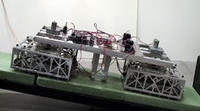-
Increase in groundwater demands due to climate change
As precipitation becomes less frequent due to climate change, lake and reservoir levels will drop and people will increasingly turn to groundwater for agricultural, industrial, and drinking water needs; the resource accounts for nearly half of all drinking water worldwide, but recharges at a much slower rate than aboveground water sources and in many cases is nonrenewable
-
-
Pasta-shaped radio waves beamed across Venice
One solution to communication congestion during emergencies is to create a public safety-dedicated band of the spectrum, allowing for a unified and uninterrupted communication among first responders; another solution is twisting radio waves into the shape of fusilli pasta, allowing a potentially infinite number of channels to be broadcast and received
-
-
Poultry feathers-based filters remove arsenic from water
Thousands of people die each year in developing countries from drinking arsenic-contaminated water; researchers develop inexpensive filters made from the modified protein (keratin) in poultry feathers to remove arsenic from drinking water
-
-
Next-gen weather satellites to improve tornado warnings in South
More than a quarter of the 1,688 twisters confirmed across the United States in 2011 occurred in the four-state region of Alabama, Georgia, Mississippi, and Tennessee – and most of the 73 tornadoes hitting the United States in January 2012 occurred in those four states; southern tornadoes are especially insidious and challenging to track, and NASA’s weather satellites are now paying special attention to them
-
-
Energy from differences between salt- and fresh water – produced inland
Production of energy from the difference between salt water and fresh water is most convenient near the oceans, but now, using an ammonium bicarbonate salt solution, researchers can combine bacterial degradation of waste water with energy extracted from the salt-water fresh-water gradient to produce power anywhere
-
-
What U.S. can learn from EU chemicals law
U.S. industry and environmental groups agree that the Toxic Substances Control Act of 1976 needs to be modernized better to protect public health and the environment; there is no consensus, however, on what the reform should look like; researchers suggest that the United States may want to look at how the EU regulates chemicals
-
-
Snake-emulating search-and-rescue robot

An all-terrain robot for search-and-rescue missions must be flexible enough to move over uneven surfaces, yet not so big that it is restricted from tight spaces; it might also be required to climb slopes of varying inclines; researchers say the solution would be a search-and-rescue robot which emulates the locomotion of a certain type of flexible, efficient animals: snakes
-
-
Asteroid 2011 AG5 worries to be justified – or not -- in February 2023
Asteroid 2011 AG5 is one of 8,744 near-Earth objects that have been discovered; it is approximately 460 feet (140 meters) in size; it is on a collision course with Earth for 5 February 2040 – but we will k now for sure in February of 2023, when it will pass Earth no closer than about one million miles, making it possible for scientists to plot its future trajectory
-
-
Researchers develop record-breaking plastic solar cell
Researchers at the University of California, Los Angeles (UCLA) have made a breakthrough with plastic solar cells, creating a record-breaking polymer cell that converts 10.6 percent of the sun’s energy into electricity
-
-
Robots to climb and assemble structures, making construction safer

In the near future, armies of robots could nimbly be crawling up towers and skyscrapers to make repairs, so humans do not have to; the design of the truss pieces, which have ridges and specially designed locks so the robot can manipulate them, is as important as the robot itself, and researchers express the hopes that in the future such robot-friendly building components would be standardized for widespread use
-
-
Physicists predict when brittle materials fail
It does not happen often, but structures like bridges, airplanes, and buildings do fail, sometimes catastrophically; what are the odds, and how can it be prevented? Researchers just published new theoretical insights into the probability of structural failures, based on hundreds of thousands of computer simulations
-
-
Detecting explosives from a distance with laser beams
Scientists have found a way to detect chemicals over long distances, even if they are enclosed in containers; the scientists tested the system by trying to detect frequently used explosives, such as TNT, ANFO, or RDX from a distance – and the tests were successful
-
-
Anthrax-decontamination foam used in meth lab cleanup
The meth cleanup problem in the United States is a big one; the U.S. Drug Enforcement Administration lists thousands of locations where law enforcement agencies have found chemicals or paraphernalia indicating the presence of either clandestine drug laboratories or dumpsites; Sandia’s decontamination foam, originally developed to deal with anthrax, is now also a meth eraser
-
-
Future aircraft could capture, re-use some of their own power
When an Airbus 320 lands, a combination of its weight and speed gives it around three megawatts peak available power; researchers work on making the aircraft of tomorrow contribute to their power needs by harnessing energy from the wheel rotation of their landing gear to generate electricity
-
-
Wireless bicycle brake to be shown in Cebit 2012

Scientists have developed a wireless bicycle brake; to brake with the wireless brake, a cyclist needs only clench the rubber grip on the right handle; the scientists say the brake has such a high reliability, only three out of one billion braking attempts will fail; “That is not perfect, but acceptable,” says one of the researchers
-
More headlines
The long view
A Shining Star in a Contentious Legacy: Could Marty Makary Be the Saving Grace of a Divisive Presidency?
While much of the Trump administration has sparked controversy, the FDA’s consumer-first reforms may be remembered as its brightest legacy. From AI-driven drug reviews to bans on artificial dyes, the FDA’s agenda resonates with the public in ways few Trump-era policies have.
Risk Assessment with Machine Learning
Researchers utilize geological survey data and machine learning algorithms for accurately predicting liquefaction risk in earthquake-prone areas.
Foundation for U.S. Breakthroughs Feels Shakier to Researchers
With each dollar of its grants, the National Institutes of Health —the world’s largest funder of biomedical research —generates, on average, $2.56 worth of economic activity across all 50 states. NIH grants also support more than 400,000 U.S. jobs, and have been a central force in establishing the country’s dominance in medical research. Waves of funding cuts and grant terminations under the second Trump administration are a threat to the U.S. status as driver of scientific progress, and to the nation’s economy.
The True Cost of Abandoning Science
“We now face a choice: to remain at the vanguard of scientific inquiry through sound investment, or to cede our leadership and watch others answer the big questions that have confounded humanity for millennia —and reap the rewards.”
Bookshelf: Smartphones Shape War in Hyperconnected World
The smartphone is helping to shape the conduct and representation of contemporary war. A new book argues that as an operative device, the smartphone is now “being used as a central weapon of war.”
New Approach Detects Adversarial Attacks in Multimodal AI Systems
New vulnerabilities have emerged with the rapid advancement and adoption of multimodal foundational AI models, significantly expanding the potential for cybersecurity attacks. Topological signatures key to revealing attacks, identifying origins of threats.
